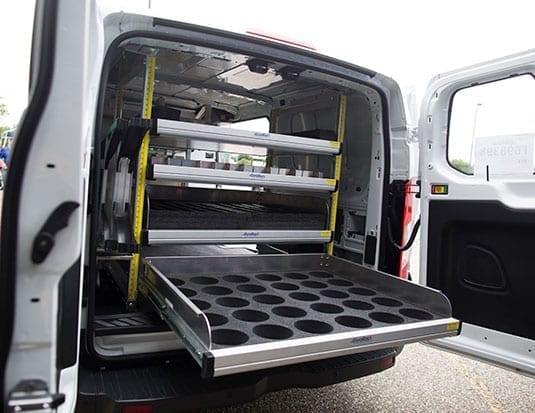Consider these key options when upfitting your next work vehicle.
The decisions you make when upfitting a work van will determine whether you end up with a vehicle that’s practical, functional, and appealing to the eye or one that looks good but falls short when it comes to being useful on a day-to-day basis.
Choosing the right partitions, shelving, ladder racks, pull-out systems, and accessories makes all the difference. Every fleet and every trade is different, however, which means that whatever works for one may not work for another. Factor in varying budgets and the overall picture gets even more complex.
The first step in any upfitting process is defining your essentials or needs, and then if space and budget allow, your wants and “nice to have” items. So let’s walk through some of the major decisions and options you’ll have to consider when upfitting your work vehicles.
Layout
When planning the layout of the interior, take into account the essential items on your list, and where they need to be placed within the vehicle. Think about items that are used daily and need to be front and centre versus heavier and bulkier items that are used only occasionally, and could be stored out of the way. Making the essential items readily available is key when designing the interior.
Shelving
Shelving comes in several lengths, widths, and heights. Knowing the dimensions of the items you need to store will allow you to plan accordingly while avoiding the need to place bulkier items on the floor because they won’t fit into the shelving.
Don’t forget smaller miscellaneous parts. Think about where you’d like to store them. Parts cases and pull-out drawer systems will help you organize these smaller items while limiting the amount of time you’ll waste later on searching for them while on the job.
Safety
A properly organized van can contribute to the safety of the driver and other occupants. Choosing the right partition, or cargo divider, for example, will prevent loose items from rolling (or flying) into the passenger area while the vehicle is in motion.
When choosing a partition keep ergonomics in mind. A straight partition, for instance, could prevent the driver from being able to adjust the seat for a comfortable ride and a position that supports the back. A contoured partition, on the other hand, eliminates these constrictions and allows the driver to adopt the proper seating position.
Other safety items to consider are laptop stands, non-slip rear floors, rearview cameras, back-up alarms and warning lights such as LED beacons or strobe lights, to name just a few.
Ladders
Most end users will need to transport heavier cargo or ladders to the job site. Selecting the right ladder rack can be overwhelming since the options seem to be almost endless: Single clamp or double clamp, single drop-down or double drop-down, or a combination (fixed and drop-down).
Knowing the type and length of ladders is also very important. Longer ladders (32 ft, for example) will require an extra bar on the front of the rack to prevent too much overhang, which would result in excess stress on the roof of the vehicle.
Drop down ladder racks are essential when procuring high roof vans since they’re easier to operate, more ergonomic and less stressful on the body.
If you’re still unsure about which options are best for your fleet, rest assured that your upfitting professional will be able to walk you through the decision-making process.



